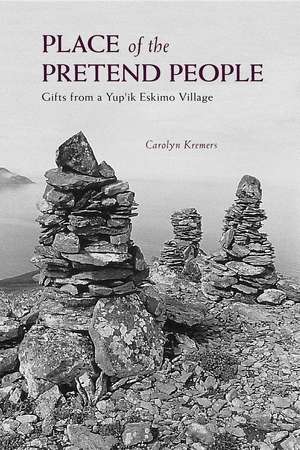Place of the Pretend People: Gifts from a Yup'ik Eskimo Village
Autor Carolyn Kremersen Limba Engleză Paperback – 31 aug 2011
Place of the Pretend People is a vivid, sensitive account of one woman's choice to live and teach in a Yup'ik Eskimo village and later to make her home in Interior Alaska. A fascinating and unusual memoir, Carolyn Kremers' book is both a journey of cultural discovery and a story of spiritual and artistic seeking.The author offers readers an intimate encounter with Yup'ik culture, modern and traditional, as she describes teaching music and English in Tununak, a village tucked along the windswept Bering Sea coast of Western Alaska. Kremers' experiences in Tununak and elsewhere provide keen insight into the lives and land of the people she grows to love. Through her friendships with Yup'ik people and others, some of the mysteries of life in a challenging northern environment are unraveled, and she begins to understand some of the mysteries within her own heart.
Preț: 71.14 lei
Preț vechi: 89.53 lei
-21% Nou
Puncte Express: 107
Preț estimativ în valută:
13.61€ • 14.13$ • 11.38£
13.61€ • 14.13$ • 11.38£
Carte indisponibilă temporar
Doresc să fiu notificat când acest titlu va fi disponibil:
Se trimite...
Preluare comenzi: 021 569.72.76
Specificații
ISBN-13: 9780882408552
ISBN-10: 0882408550
Pagini: 250
Dimensiuni: 155 x 228 x 17 mm
Greutate: 0.38 kg
Ediția:Nouă
Editura: ALASKA NORTHWEST BOOKS
ISBN-10: 0882408550
Pagini: 250
Dimensiuni: 155 x 228 x 17 mm
Greutate: 0.38 kg
Ediția:Nouă
Editura: ALASKA NORTHWEST BOOKS
Notă biografică
A Colorado native, Carolyn Kremers wanted to live in the Alaskan bush. She accepted an invitation to teach music and English at a school in a remote Yup'ik Eskimo village on Nelson Island, in Western Alaska on the Bering Sea. After teaching for two years in the village of Tununak, she moved to Alaska's Interior, and today she teaches writing and literature part-time at the University of Alaska Fairbanks.
Kremers earned undergraduate degrees in English and honors humanities from Stanford University and in flute performance from Metropolitan State College in Denver, Colorado. She completed her teaching credential at the University of Illinois Chicago, and she holds an MFA in creative writing from the University of Alaska Fairbanks.
Early in her career, Kremers received a special citation from the PEN/Jerard Fund Award for emerging women writers of nonfiction. Since then, her essays and poems have appeared on public radio, on the Internet, and in numerous journals, magazines, and anthologies. In 2008-09, she was a Fulbright Scholar in Ulan Ude, Russia. She lives in a log cabin in a birch forest outside Fairbanks.
Kremers earned undergraduate degrees in English and honors humanities from Stanford University and in flute performance from Metropolitan State College in Denver, Colorado. She completed her teaching credential at the University of Illinois Chicago, and she holds an MFA in creative writing from the University of Alaska Fairbanks.
Early in her career, Kremers received a special citation from the PEN/Jerard Fund Award for emerging women writers of nonfiction. Since then, her essays and poems have appeared on public radio, on the Internet, and in numerous journals, magazines, and anthologies. In 2008-09, she was a Fulbright Scholar in Ulan Ude, Russia. She lives in a log cabin in a birch forest outside Fairbanks.
Comentariile autorului
Most writing about Alaska has been done by men and often by men from outside of Alaska. Much of the limited writing about Yup'ik people has been done by anthropologists for scholarly purposes. Although my writing is based on observation and research, it is also based on intimate personal experience and emotion, and it is not scholarly but literary and narrative in style.
-----Carolyn Kremers
-----Carolyn Kremers
Extras
Months later, I would hike up the hill to the north on Saturday or Sunday afternoons, past the place where Mark said perhaps two sod houses used to be. About a mile away, up among the jumbled rocks displaced by permafrost, I would reach the Pretend People.
Eight stacks of stones—flat, lichen-covered rocks placed neatly on top of one another—kept watch on the mountainside and gazed out at the Bering Sea. Cliffs rose from the beach below and sometimes, walking along the shore at low tide, I would see a peregrine falcon soar above my head and disappear in the cliff shadows, returning to a nest.
The first time that I climbed to the Pretend People, the hill was so windy I could hardly keep my balance. But the visit was worth it. Something could be heard.
From Chapter 3, "Give Thanks," Place of the Pretend People.
Eight stacks of stones—flat, lichen-covered rocks placed neatly on top of one another—kept watch on the mountainside and gazed out at the Bering Sea. Cliffs rose from the beach below and sometimes, walking along the shore at low tide, I would see a peregrine falcon soar above my head and disappear in the cliff shadows, returning to a nest.
The first time that I climbed to the Pretend People, the hill was so windy I could hardly keep my balance. But the visit was worth it. Something could be heard.
From Chapter 3, "Give Thanks," Place of the Pretend People.
